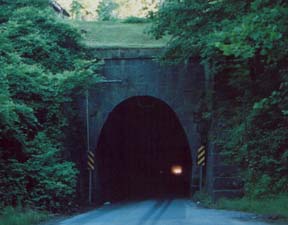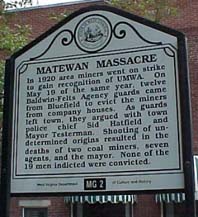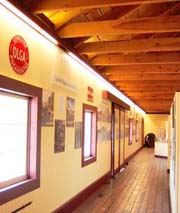 |
 |
|
Gassaway
|
 |
|
Dundon
|
 |
Ansted
Gauley Bridge
Glen Jean
Mt. Hope
Thurmond |
 |
|
Alum Creek
Branchland
|
 |
|
Logan
|
 |
|
Davy
Iaeger
Kimball
Roderick
Twin Branch
War
Welch
|
 |
|
Historic Matewan
Williamson
Dingess
Red Jacket
|
| County Commission |
 |
|
Itmann
Mullens
Oceana
Sabine
Wyco
Wyoming
|
|
|
|
|
|
|
|
|
DELBARTON - DINGESS - KERMIT - MATEWAN - RED JACKET - WILLIAMSON
|
|
HISTORY
|
DELBARTON
Railroads came to what would become the town of Delbarton in 1908 and four coal mines were opened in 1921. On July 21, 1921, the first coal was mined. It was not until September 6, 1946 that the community incorporated after many name changes. Click here for more information about Delbarton.
|
| DINGESS TUNNEL
This 100 year old, former train tunnel was converted into a highway tunnel in the 1960's. The Dingess Tunnel is just under a mile long and is rumored to be haunted by the victims of train accidents from its past. Driving through the tunnel road is only one lane wide so those driving through the tunnel must drive slowly, flash their lights and blow their horn to warn travelers at the other end not to enter. It's like going on a fun house ride without ever getting out of your car. Don't worry though, there have been very few accidents and it is lots of fun.
|
 |
|
| There are also 33 bridges, all of which at one time served the Twelve Pole Line of the Norfolk & Western Railway between Lenore and Wayne which has become part of County Route 3/5. Many of the railroad station buildings along the old line were sold to individuals and have now been converted into homes and stores. Click here for more about the Dingess Tunnel. |
|
| KERMIT
The town of Kermit, located on the western border of Mingo County, was incorporated on December 15, 1909. The coal mines and the gas and oil industries in the area developed early in the century and when Norfolk & Western Railway Company decided to run its first line to Kenova, the community began to grow.
The first coal mine, Warfield Coal Company, was opened in 1904 near Kermit and was later succeeded by Gray Eagle Coal Company in 1913. Click here for more information on Kermit.
|
|
 |
MATEWAN
Matewan has intrigued visitors and inspired folklore for over one hundred years. In the 1880s, the feud between the Hatfields and McCoys raged near Matewan. Forty years later, the town was the scene of a fatal conflict between mine workers and coal operators which became known as the Matewan Massacre.
Located on the Tug Fork of the Big Sandy River, Matewan was founded in 1895 soon after the Norfolk and Western Railway entered the valley to open the Williamson coal field. A depot was built in the late 1800’s and Matewan became a major stop on the N&W's main line, providing goods and services to the surrounding mining communities. more on what to see today ...
|
|
|
| RED JACKET
In 1890, William McClellan Ritter and John Paulhamus came from Pennsylvania to Bluefield, WV and started the Ritter Lumber Company to capitalize on the development of railroads through the area which would open up the markets both east and west. Ritter Lumber grew into a giant industry. It is still one of the world's largest hardwood industries today.
A few years later, Ritter realized Appalachian timber was becoming scarce and decided to invest in coal. He bought Red Jacket Corporation which had a 750,000 ton capacity per year. The coal business developed as rapidly as Ritter Lumber. Within a short time, Red Jacket had five plants in operation with some six million tons of undeveloped coal on Ritter Lumber Company land. Coal camps were established and Red Jacket became a thriving community. Click here to see what one can see today.
|
|
| WILLIAMSON
Railroading and coal mining have long been the major industries in the area. Floods in the past years, particularly the major one in 1977, were responsible for the losses of various businesses in the city. Besides coal, natural gas is another of the basic resources in Mingo County. The Norfolk & Western Railway, a subsidiary of Norfolk Southern Corporation, is the largest single employer of the Tug Valley area. The East Williamson Yard is one of the largest coal marshaling yards in the world. Click here for more about Williamson.
|
 |
|
|
A few of the places of interest in Williamson include:
- City Hall (located in the N&W's passenger station which was donated to the city some years ago and converted with grant funds to a modern facility)
- The former N&W Freight Station (which now houses the Williamson Daily News)
- A railroad caboose and dining car located on Third Avenue
- The Coal House - One of two buildings in the world made entirely out of coal. This site is also the informal visitors center for the area and has a lot of memorabilia related to the region.
- The Williamson Railroad Museum
- One of the largest train switching yards in America. Over a billion dollars worth of coal has passed through this train yard.
- Williamson Round House - one of the few round houses still operating in the country.
- Hatfield & McCoy Feud
|
|
|
|
Mingo County is part of the NCHA*, an 11 county initiative* in West Virginia“...to preserve, protect, and interpret lands, structures, and communities with unique and significant historic and cultural value associated with the coal mining heritage of West Virginia.” The counties of Boone, Cabell, Fayette, Logan, McDowell, Mercer, Mingo, Raleigh, Summers, Wayne, and Wyoming are participants in this initiative. Go to http://www.coalheritage.org/ for more information.
*The National Coal Heritage Area (NCHA) is one of only 22 nationally designated heritage areas in the entire United States.
|
| For an inventory of all the tourism related offerings in Mingo County West Virginia, click here. |
|
|
|
|

